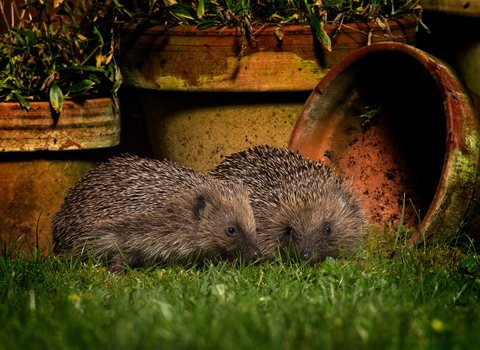Hedgehogs are undergoing concerning declines. In rural areas, over 50% have been lost in the past two decades and in urban areas, up to a third of populations have been lost between 2000 and 2014. There is however hope; a recent report by People's Trust for Endangered Species and British Hedgehog Preservation Society indicates that the decline in our towns and cities may be slowing, suggesting the actions that people are taking in their own neighbourhoods could be making a real difference.
For such a small animal, hedgehogs range over a surprisingly large area and in a single night a male hedgehog can travel 2-3 kilometres. The hedgehog that visits your garden will therefore be roaming far and wide - and to do this they need interconnected patches of feeding and nesting habitat.
Our modern landscape fragmented by houses, roads, walls, fences and farming, is an increasingly difficult place for hedgehogs to navigate safely. Reversing the decline of hedgehogs will be a challenge, but creating a network of Living Gardens linked in to a rich Living Landscape is a good place to start.
How you can help:
Manage your garden for hedgehogs
Found a hedgehog that may need help?
Our friends at Hedgehog Street are recording hedgehog sightings, please add your records to their map .
Wild About Gardens Hedgehog Booklet
Status
IUCN Red List Least Concern but marked declines in the UK make it a UK Priority Species. Between the years 2000-2014, urban populations have declined by up to a third, and rural populations by over half. See the State of Hedgehogs 2022 Report for more information.
Diet
Feeds mainly on macro-invertebrates such as beetles, caterpillars, earthworms and spiders and will infrequently eat eggs, frogs and fallen fruit.
Habitat
Found in a wide range of habitats, both in urban and rural areas. Common in gardens but in rural areas tend to utilise edge habitats and hedgerows. Absent from wet habitats, pine forests and mountainous regions.
Hibernation
This is a flexible process influenced by temperature and food availability. Hogs will often wake up several times during winter and may even move nests. Winter nests are made from fallen leaves under support structures such as log piles, brambles or sheds.
Movement
Can travel ~2km in night, making access through gardens incredibly important. One hedgehog has been recorded travelling 9km in one night!
Breeding
Can breed any time between April- September with the peak season being May-June. Litter sizes are often 4-5 hoglets, with just 2-3 of these surviving to independence.
Predators
The main predator of the hedgehog is the European badger, but it can also be predated upon by foxes and pet dogs.
Disease & Parasites
Parasites are common inhabitants of hedgehogs, especially fleas (which are specific to hedgehogs) and ticks. The presence of these are normal, though overburden of ticks may be indicative of general ill health. Hedgehogs can also have ringworm, lungworm and Salmonellosis.
Threats
Hedgehogs face a wide range of threats, though the causes of decline are not fully understood. Loss of habitat and habitat fragmentation through farming practises and urbanisation are a large issue. Impermeable boundaries such as fences and walls make navigating urban areas difficult and over-tidy gardens reduce important habitat. Other threats include reduced abundance of invertebrates from chemical use, habitat deterioration combined with increased badger density, and the unknown impacts of disease and climate change.
Conservation Action
The national campaign Hedgehog Street is mobilising community action to help improve the status of hedgehogs across the UK. Other important action conducted by organisations and universities in the UK includes scientific research to better understand the species ecology, population status and threats, development of survey methodologies, and working with housing developers and land managers to increase awareness and enable hedgehogs to be considered in their plans.

